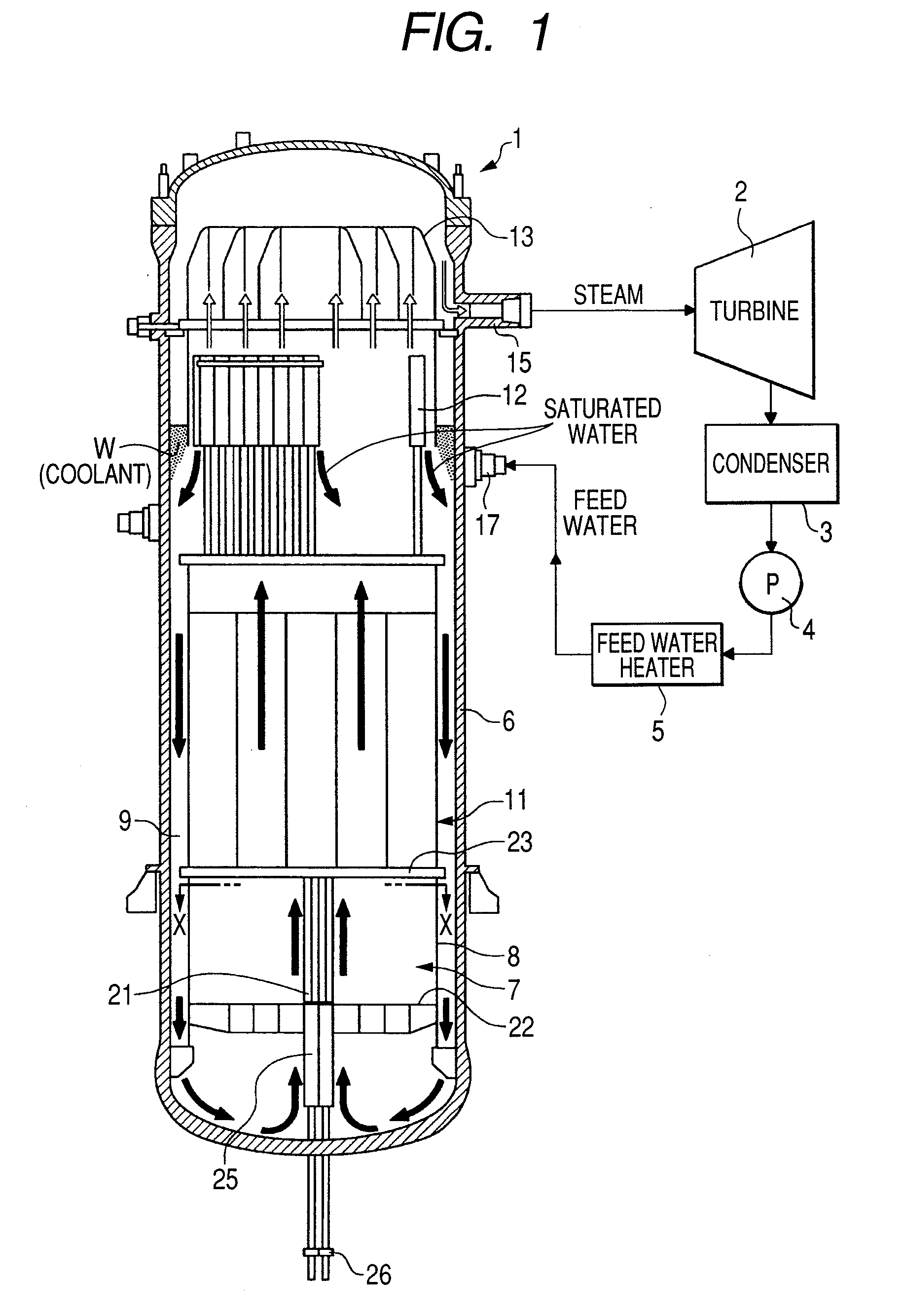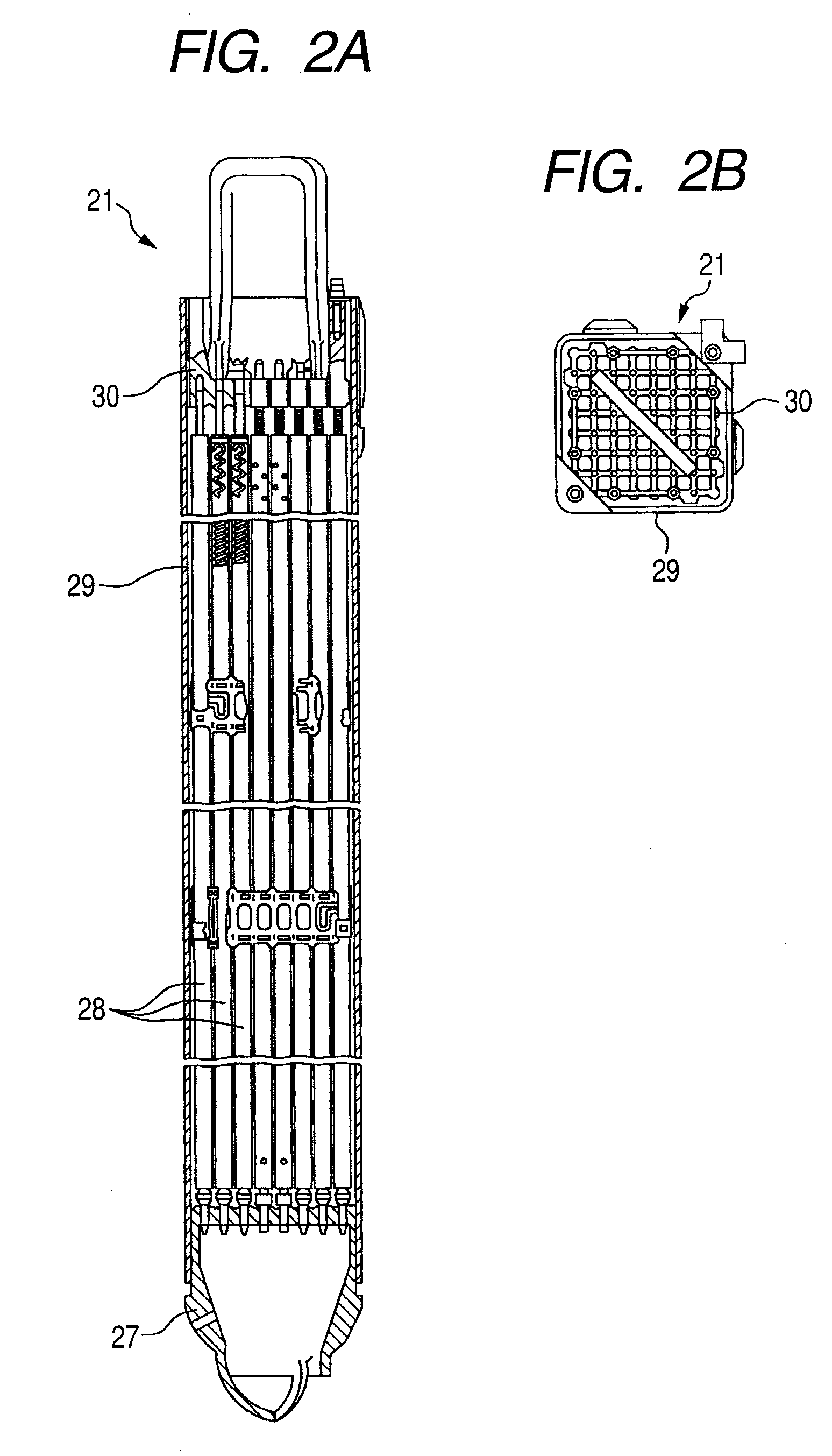Natural circulation boiling water reactor
a technology of boiling water and boiling water, which is applied in the direction of nuclear reactors, nuclear elements, greenhouse gas reduction, etc., can solve the problems of reducing the reactivity of the core, and achieve the reduction of the thermal margin in the core, the reduction of the reactivity of the core, and the effect of increasing the thermal margin
- Summary
- Abstract
- Description
- Claims
- Application Information
AI Technical Summary
Benefits of technology
Problems solved by technology
Method used
Image
Examples
first embodiment
[0038]The following is a description of the first embodiment of the present invention. FIG. 5 shows the fuel assemblies loaded in the core in only the region which is the upper left quarter shown in FIG. 4. The region not shown in FIG. 5 can be considered to be a figure in which the region in FIG. 5 is rotated 90°, 180°, and 270° clockwise around the core plane center 40 and thus for simplification, a quarter of the diagram is described.
[0039]As shown in FIG. 5, in the first embodiment, the core 7 is divided into three regions in a radial direction. That is to say, the core 7 is divided into three regions including one layer (referred to as an outermost region hereinafter) 51 at the outermost side of the core 7, two-three layers (referred to as an outer region hereinafter) 52 inside the outermost region 51 and other layers (referred to as an inner region hereinafter) 53 inside the outer region 52. The outermost region 51 is first region, the outer region 52 is second region and the ...
second embodiment
[0050]The following is a description of the second embodiment of the present invention. FIG. 6 shows the fuel assemblies loaded in the core in only the region which is the upper left quarter shown in FIG. 4. It is to be noted that the method for viewing the diagram is the same as in the first embodiment and thus a description thereof has been omitted.
[0051]As shown in FIG. 6, in the second embodiment, the core 7 is divided into three regions in a radial direction. That is to say, the core 7 divided into three regions including one layer (outermost region) 61 at the outermost side of the core 7, two-three layers (outer region) 62 inside the outermost region 61, and other layers (inner region) 63 inside the outer region 62. The outermost region 61 is first region, the outer region 62 is second region and the inner region 63 is third region. It is to be noted that as is the case in the first embodiment, the number of layers in each region is not limited by that shown in the drawing and...
third embodiment
[0062]The following is a description of the third embodiment of the present invention. FIG. 7 shows the fuel assemblies loaded in the core in only the region which is the upper left quarter shown in FIG. 4. It is to be noted that the method for viewing the diagram is the same as in the first embodiment and thus a description thereof has been omitted.
[0063]As shown in FIG. 7, in the third embodiment, the core 7 is divided into three regions in a radial direction. That is to say, the core 7 is divided into three regions including one layer (outermost region) 71 at the outermost side of the core 7, two-three layers (outer region) 72 inside the outermost region 71 and other layers (inner region) 73 inside the outer region 72. The outermost region 71 is first region, the outer region 72 is second region and the inner region 73 is third region. It is to be noted that as is the case in the first embodiment, the number of layers in each region is not limited by that shown in the drawing and...
PUM
 Login to View More
Login to View More Abstract
Description
Claims
Application Information
 Login to View More
Login to View More - R&D
- Intellectual Property
- Life Sciences
- Materials
- Tech Scout
- Unparalleled Data Quality
- Higher Quality Content
- 60% Fewer Hallucinations
Browse by: Latest US Patents, China's latest patents, Technical Efficacy Thesaurus, Application Domain, Technology Topic, Popular Technical Reports.
© 2025 PatSnap. All rights reserved.Legal|Privacy policy|Modern Slavery Act Transparency Statement|Sitemap|About US| Contact US: help@patsnap.com



